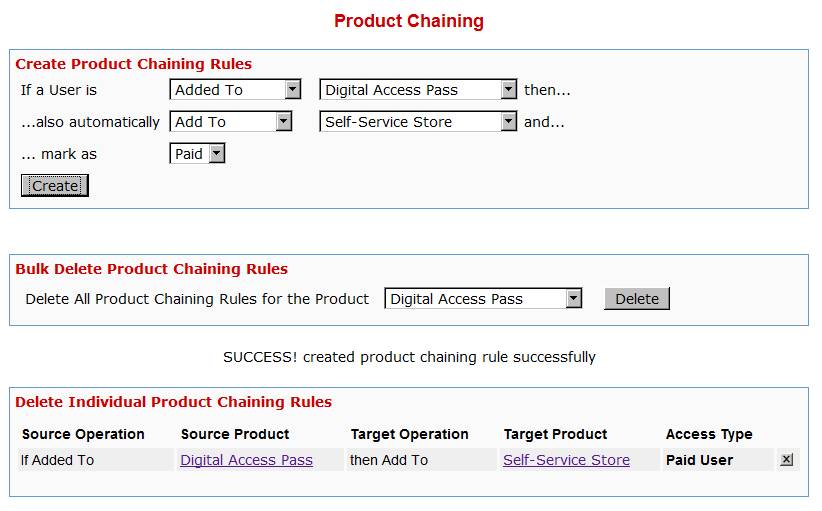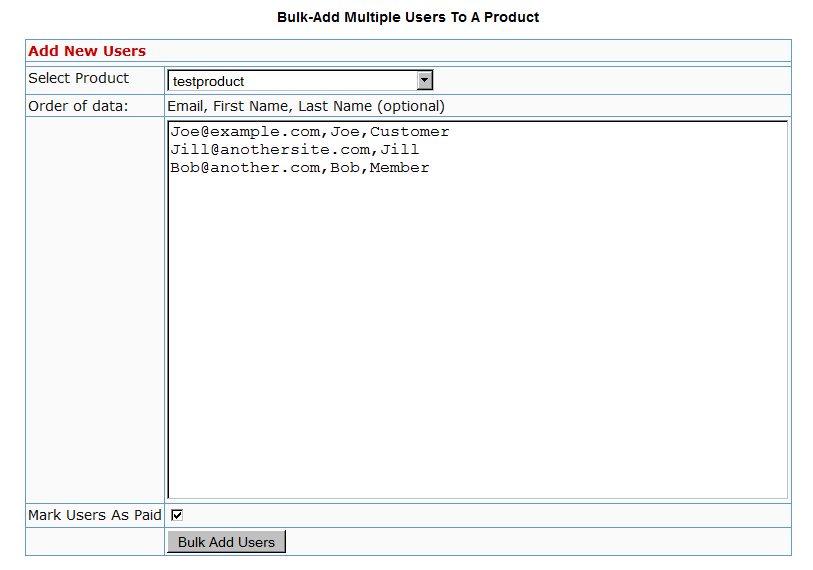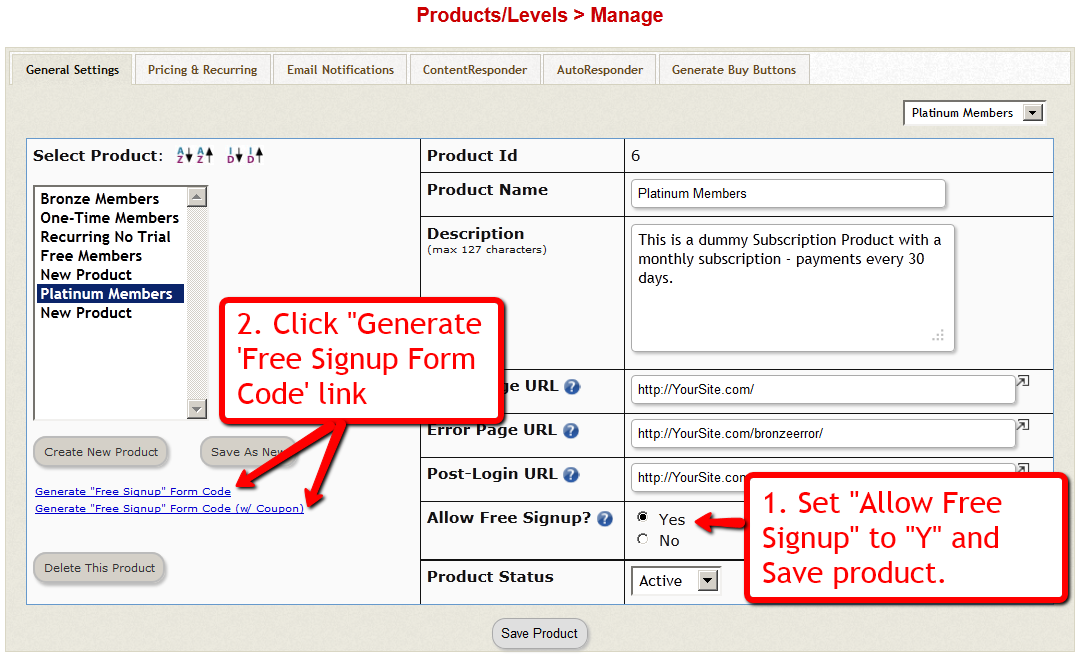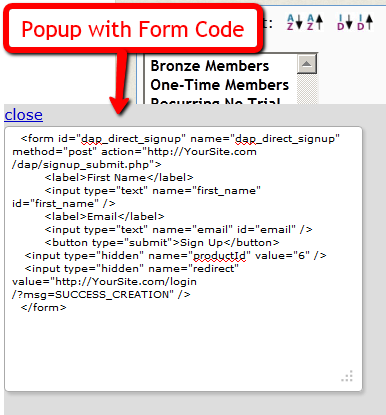How To Use DAP’s Default Password
DAP has a feature where you can ask DAP to always generate a pre-determined, default password of your choice for all new members.
So all new users will be assigned the same default password, which of course, they can change as soon as (or any time after) they login.
This is especially useful if you want a third-party service like Aweber – instead of DAP – to send out the new member’s “Welcome Email” which contains their email and password.
Since DAP is unable to pass the randomly generated password to Aweber, instead, you can setup a default password by going to
Setup > Config > Default Password
This can be found under the Miscellaneous section on that page.
So if you set this password to say, changethis, then DAP will give out the same password to all new users.
Then, in the welcome email you configure at, say, Aweber, you would put the Aweber merge code for email id, and then enter this pre-selected password (because you already know what it is) into your Aweber email, like this:
Hello {!firstname},
Welcome to Example.com. You may log in to your member’s area at:
Email: {!email}
Password: changethisThank you,
– Admin from Example.com
And if you ever change the default password in DAP, don’t forget to also change it in your welcome email at Aweber (or 3rd party email service).
Also, don’t use the default password in any subsequent emails, other than the Welcome email (very first email sent to member through Aweber), because the member may have already changed their password by then.
WARNING: You must have also set up DAP/Aweber integration first before you attempt to do this.
Product Chaining
Product Bundling
Any time someone gets access to PRODUCT A (either through direct signup, manual admin add, or purchase), then you can automatically give them access to PRODUCT B. And you can select whether they get PAID access to PRODUCT B or not.
Similarly, when someone is removed from PRODUCT A, you can also tell DAP to automatically remove their access to PRODUCT B.
Very useful for bundling products.
Product Access Automation
User signs up as free user to PRODUCT A.
Later on, user buys PRODUCT B (which is, say, paid version of PRODUCT A).
If you set up Product Chaining, then you can automatically remove them from PRODUCT A when they purchase PRODUCT B. So when you send an email to all PRODUCT A users asking them to purchase access to PRODUCT B, then you won’t be sending emails to those who have already purchased PRODUCT B.
Click on image below to open full size in a new window.
“ProductLinks” Widget: Product-Specific Content
You already know that you can create a “My Content” kind of page within WordPress, that will list all products that a user has access to, and then each product will list the content that they currently have access to (content that has already dripped on them).
But this page is a full-summary of all products, all listed on one page.
Instead, if you wished to create product-specific download pages, where you create a separate page for each product, that lists all the content within just that product alone, then that’s where DAP’s “ProductLinks” Widget comes in handy.
Here’s how you set it up.
- In WordPress admin, go to “Appearance > Widgets” and enable the “DAP ProductLinks” widget by dragging it onto a widgetized section of your theme’s sidebar.
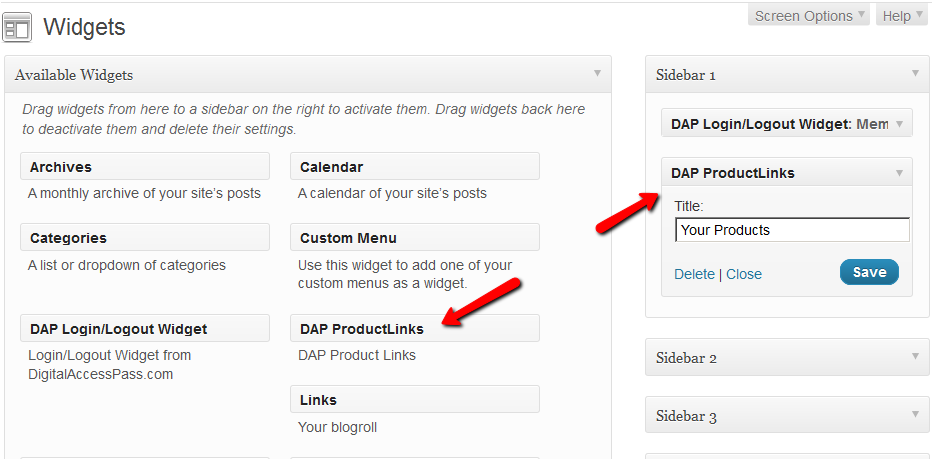
- As soon as you do that, the DAP ProductLinks widget will show up in your blog’s side bar.
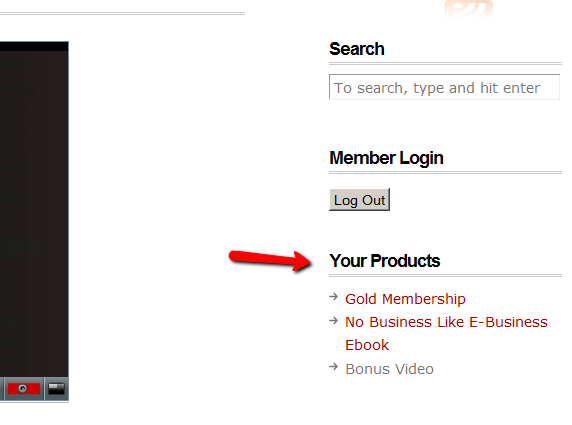
- By default, each of the product names – like “Gold Membership” in the above example – will link to whatever URL you put into the “Post-Login URL” for that particular product (DAP Dashboard > Products > Manage). So the next step is to create a separate page for each product, and then enter the permalink for this new page, into the Post-Login URL of that Product within DAP.
- Create a new page in WordPress – call it, “Gold Membership Content” (for example). In the body of the page, enter the following DAP merge tag:%%PRODUCT_DETAILS_<id>%%
Replace the entire text <id> with the actual Product id from DAP (Products > Manage)
So, if the product’s id is 6 in DAP, then the merge code becomes:
%%PRODUCT_DETAILS_6%%
Save the page. And if you gave the page the title “Gold Membership Content”, then the permalink for this page will be:
http://YourSite.com/gold-membership-content/ - Take the above permalink and enter it into the product “Gold Membership” in the “Post-Login URL” field. That’s it!
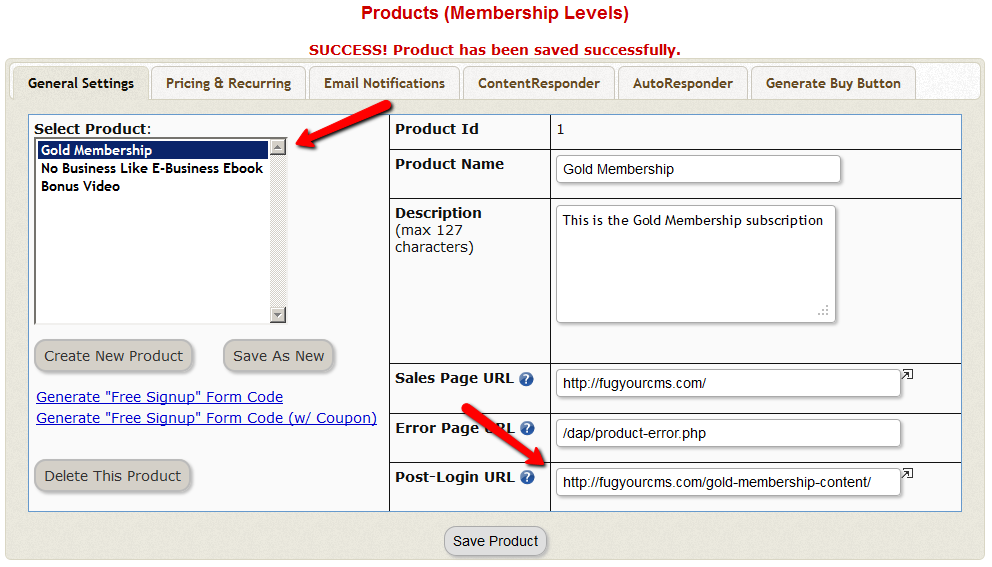
- Do the above for all products and you’re done.
End Result
- For each product that your member buys, the “Your Products” widget will show in the side-bar.
- It will list all of the products that the member has purchased.
- Each of the product names will link to it’s own specific content page
- When member goes to that page, the DAP merge tag you entered for that product will expand into product details and product-specific content links just for that product.
Importing Users In Bulk Into DAP
DAP allows you to easily import users in bulk from an external system or database.
Importing users in bulk is the same as adding users one at a time using the single-user-add feature. So whichever way you manually add users, DAP is going to all of the following…
- Create a new account for them using the email with which they’re being added
- Auto-generate a random, unique password for them
- Give them access to the product (into which they’re being imported or being added to)
- Send out the Welcome Email as per the product’s settings (this welcome email can be configured to send them the email & password to the member’s area along with anything else you want)
- Add them to the autoresponder series configured for that product
- … and so on.
When you do a single-user-add, all of this is done for that user in real-time. When you do a bulk-add, then all of the above happens for each user being imported, one at a time, when the DAP hourly cron job runs at the top of every hour. That’s the main difference.
Simple Import
Prerequisites For Simple Import
1) You must have already created the DAP Product into which the users will be imported
2) The user list has to be in a CSV (comma separated) format (one user per line)
For doing a simple import of user data containing just email, first and/or last name, the format of data (per user, per line) should be like this:
Email,FirstName,LastName
Email and FirstName are mandatory. But LastName is optional. So your user data row could be just…
Email,FirstName
Example:
Joe@example.com,Joe,Customer
Jill@anothersite.com,Jill
Bob@another.com,Bob,Member
How to do the actual Import
- Go to Users > Add > “Bulk-Add Multiple Users To A Product”
- Paste your CSV list into the large text area
- Select the Product into which you want to import the users
- Check the “Mark Users as Paid” checkbox if you want them to have “Paid” access to the content (just as if they are actual paying members). If you don’t check it, they will all have access as a “Free” user (instead of a “Paid” user), which means they will only have access to content within the Product that you have marked as “Free”.
- Click on the “Bulk Add Users” button. That will first save this entire list as a CSV file in your /dap/bulk folder on your site. And then, the next time the Hourly cron (dap-cron.php) runs, it will add them one by one to the product, and send them emails as per your Product set up. So if your Product has the “Thankyou-Email” subject and body filled out, it will individually send out each of the users that thankyou email.
Extended Import
DAP will also allow bulk import of users with extended profile information. This includes their existing password and other profile data as detailed in this video (Bulk Add Users)
But please make sure you are using at least DAP v4.2.1 and LiveLinks v1.7, because what’s explained below is only available only since then.
Pre-requisites For Extended Import
1) You must have already created the Product into which the users will be imported
2) The user list has to be in a CSV (comma separated) format (one user per line), with the exact format being:
Email,Firstname,Lastname,Password,ProductName, Address,City,State,Zip,Country,Phone,Company, Flag (to indicate Paid or Free user), Access Start Date, Access End Date,UserName
Example:
joe@somesite.com,Joe,Member,test123,Example One-time Product,99 hill ave,Cityname,NY,10001,USA,,Plug and Play Inc,y,2011-03-16, 2012-03-15,JoeMember
The only required fields are Email, FirstName and ProductName. If you do not want to supply a value for any of the optional fields, but still wish to import certain others, then just leave those fields empty in the data row (but the commas should remain) as shown below.
Email,Firstname,,,ProductName,,,,,,,,Flag (to indicate Paid or Free user), Access Start Date, Access End Date,UserName
How to do the actual Import
Create a file with the name /dap/bulk/importusers.csv file so it has the users you want to import in the format specified above.
Run this script on your browser to complete the import, by visiting:
http://YourSite.com/dap/dap-bulkImport.php
Note:
* Replace “YourSite.com” with your actual domain name
* Limit the number of users you are importing with this method to not more than 500 users (rows) at a time. Otherwise the import may timeout, because the import occurs real time, because you’re running the script manually, and not via cron. If the user already exists in dap, then the script will just skip that user and move on to the next user in the bulk add list.
Duplicating Products
If you have multiple products that have quite similar settings and content, you could save time by starting with just one product (either the lowest level, or the highest level), and then using the “Save As New” button to make an exact copy of that product, and then adding or removing content from this new copy to create new products.
So, let’s say you have say 3 membership levels: Silver, Gold and Platinum.
“Gold” will have all the content that “Silver” has, plus some more.
“Platinum” will probably have everything from “Gold”, plus some more.
So the way you could save time setting up all these 3 levels, is to either start with the lowest level, or the highest level.
Let’s say you start with the lowest level, “Silver”.
So create the “Silver” product fully, set up all the content dripping, email dripping etc.
And then once you’re done, while still editing the “Silver” product, click on the “Save as New” button (next to the “Save” button on the Product page).
That will create an exact duplicate of the “Silver” product – with all of its settings, content dripping and email dripping intact. And this copy will be called “Silver Copy” (just the text Copy added to the end). And this new copy will already be selected for you.
Now rename this new product from “Silver Copy” to “Gold”, save it, and then continue to add more content to it.
Then, finally, when “Gold” is fully ready, again do a “Save As New”, which would create a “Gold Copy” product.
Rename the “Gold Copy” product to “Platinum”, save it, and continue to add more content and emails to it.
Get the drift?
NOTE: On the flip site, you could also start by creating the “Platinum” product first, and then keep doing a “Save As New” and continue stripping out content to create the lower membership levels.
Free Signups: Adding Users Via DAP Signup Form
DAP allows you to create an opt-in form to directly sign-up users to your Product (which also acts as a “list” if you only want to drip or broadcast emails).
This is very similar to creating a sign-up form at Aweber or 1ShoppingCart, and allowing people to directly sign up by entering just their First Name & Email Id.
How To Generate Free Signup Form Code
In the DAP Admin menu, go to Products > Manage , and pick the product for which you wish to create the free signup form
1) Set “Allow Free Signup” to “Y” and then first save the product.
2) Once product is saved and page reloads, now click on the first link that says Generate ‘Free Signup Form Code’ link.
(NOTE: This is for advanced DAP users only: Second one (that says w/ Coupon) generates the free signup form code along with an extra field for entering a coupon code – use this if you want the person signing up to also enter a coupon code before they can sign up for the product – you must have previously created the Coupon code under “Payment Processing > Coupons” page.
3) That will bring up a little pop-up that will have the HTML for the signup form.
4) The form looks something like this:
<form name=”dap_direct_signup” method=”post” action=”http://www.YourSite.com/dap/signup_submit.php”>
<table>
<tr><td>First Name: </td> <td><input type=”text” name=”first_name” size=”10″></td></tr>
<tr><td>Email:</td> <td><input type=”text” name=”email” size=”10″></td></tr>
<tr> <td colspan=”2″><input type=”submit” name=”Submit” value=”Sign Up”></td></tr>
</table>
<input type=”hidden” name=”productId” value=”1″>
<input type=”hidden” name=”redirect” value=”http://YourSite.com/login/?msg=SUCCESS_CREATION““>
</form>
Copy and Paste the above form into any HTML page, or WordPress Page or Post where you want the free sign-up form to appear.
The form already has all the code required to add the user to your member database, with “Free” access to the Product (for which you generated the HTML code)
That’s it!
Additional Fields On The Signup Form
We also allow the following additional fields to be accepted via the direct signup form:
first_name, last_name, user_name, email, address1, address2, city, state,zip,country, company,phone,fax,title,paypal_email
Take the direct signup form code from the dap products page, and to that, you can add additional attributes with the following names:
For ex:
If you want to accept the user’s paypal email address, the just that to the form code above:
<tr>
<td>Paypal Email:</td>
<td><input type=”text” name=”paypal_email” size=”10″></td>
</tr>
Frequently Asked Questions
Can this form be published on any site? Or can it be published only on the site where DAP is installed?
This form can be published on any web site – can be completely different from the site where DAP is installed. Please note that the above form submits to the url “http://www.YourSite.com/dap/signup_submit.php” – so doesn’t matter which site this form is published on, the user is always added to the site where DAP is installed, which is http://www.YourSite.com.
What happens after user signup?
If you note the text in bold in the above form (reproduced below)…
<input type=”hidden” name=”redirect” value=”http://YourSite.com/login/?msg=SUCCESS_CREATION“>
… you’ll see that the default form redirects to the page http://YourSite.com/login/?msg=SUCCESS_CREATION (which is the login page from your Setup > Config) and on that page, displays on the message “Success! Your membership account has been created. Check your email addresss in a few minutes for your password”.
After Sign up is complete, how to redirect to a link of my choice?
In the form, you can modify the field in the form named “redirect” to any URL of your choice. Here are some examples:
<input type=”hidden” name=”redirect” value=”http://www.SomeOtherNonDAPSite.com/thankyou.html“>
OR
<input type=”hidden” name=”redirect” value=”http://www.YourSite.com/2010/12/31/thank-you“>
DAP Scenarios (Use Cases)
The Basics
When you configure a product as “Free”, you can use a “Free Signup Form” to sign up users for that Product.
If not, then the only way for people to get access to that Product, is to either buy it, or for the DAP Admin to give them access to it manually.
Now, let’s see the different ways in which you can use DAP.
Case 1: How to use DAP as an Email List
- Create and save a Product (a DAP “Product” is same as “Membership Level” same as “Email List”)
- Just add the Autoresponder email sequence to this product.
- No need to add any content, because you’re not dripping content, but dripping just emails.
- Click on the “Direct Signup HTML” link and copy the HTML
- Publish the HTML on any page of your site, just like you would publish a signup form from Aweber or GetResponse.
- The form collects “First Name” and “Email” from your visitor
- Anyone who signs up through this form is given access to that Product, and added as a “Free” user
- You can continue to drip autoresponder emails on them, and also send them email broadcasts.
Case 2: Free Sign-up. Then Promote Paid One-off Products
- There are no time limits or trials here. User signs up for free. You continue to promote your products to them.
- You will need to create 2 products here – 1 Free and 1 Paid
- Create your paid Product – “Paid Product 1” as a Non-Subscription product (Is Recurring = No)
- Set up the content protection, dripping (if any) and emails.
- Create a new free Product – “Free Product” – (which contains just free content and autoresponder emails)
- Use Direct-Signup to signup users for “Free Product”.
- “Joe Customer” signs up for free through this form, and becomes a free member.
- Keep dripping free content and emails on them. In the emails, you can promote the sales page(s) for your Paid Product(s).
- When Joe Customer eventually buys “Paid Product 1”, then now Joe automatically get access to “Paid Product 1”.
- When you search for Joe Customer’s email on the Users > Manage screen, you will see that Joe now has access to 2 products: “Free Product” and “Paid Product 1”
Case 3: Free Trial with Forced Continuity Forever
- You offer a 30-day free trial. After trial, subscription payments every 30 days, forever, until they cancel their subscription.
- Set up a Product in DAP as…
Is Recurring: Yes
Recurring Cycle 1: 30
Recurring Cycle 2: 30
Recurring Cycle 3: 30 - You can’t really do a “free” trial. You must charge at least 1 penny ($0.01) [because otherwise, Paypal (for instance) doesn’t send the right information in the IPN. And credit card processors won’t even validate the credit card if you try to charge $0.00, so when it’s time for the subscription to be charged after a month, you will see a lot of declines and rejected cards].
- Set up your buy button (in Paypal, ClickBank, 1ShoppingCart, etc) to match the above subscription set up in DAP (from Step #2 above): A $0.01 trial for 30 days, then recurring payments of $X every 30 days, forever (never ends).
- Make sure you use the same Product Name in both DAP and in your buy button.
- Publish the button on your sales page. When someone clicks on the button and signs up (you’ve already set up the payment processor integration during setup), DAP will automatically give them access to this product for 30 days (Recurring cycle 1).
- After 30 days, if subscription payment comes in as scheduled, then the user’s “Access End Date” is extended by another 30 days. So they will get access to all the dripped content from Day #31 to Day #60.
- If user cancels before the trial is over (or their subscription payment fails for some reason), then their “Access End Date” stays the same, which means it automatically expires.
Case 4: Paid Monthly Recurring Product with No Free Trial
- Create a Product in DAP as…
Is Recurring: Yes
Recurring Cycle 1: 30
Recurring Cycle 2: 30
Recurring Cycle 3: 30 - Set up your buy button (in Paypal, ClickBank, 1ShoppingCart, etc) to match the above subscription set up in DAP (from Step #1 above): Instant payment of $X + Recurring payments of $Y every 30 days, with an forever (never ends).
- Make sure you use the same Product Name in both DAP and in your buy button.
- Publish the button on your sales page. When someone clicks on the button and signs up (you’ve already set up the payment processor integration during setup), DAP will automatically give them access to this product for 30 days (Recurring cycle 1).
- After 30 days, if subscription payment comes in as scheduled, then the user’s “Access End Date” is extended by another 30 days. So they will get access to all the dripped content from Day #31 to Day #60.
- If user cancels before the trial is over (or their subscription payment fails for some reason), then their “Access End Date” stays the same, which means it automatically expires.
Case 5: All Free Content, Available only to “Registered” Members, Dripped Content
- You wish to make all of your content available for free, but users must “Register” first (i.e., sign-up using their email id) so that you can continue to send them emails and drip content so that they don’t get it all on day #1 and then un-subscribe from your list.
- Create a Product, say, called “Marketing Tips”.
- Set “Is Recurring” to “N”.
- Add content to this product (blog posts, files, etc). Set up the drip for this content (day #1, day #7, etc)
- Set up email autoresponders, if any, and add to this product.
- Click on “Direct-Signup HTML” on the Product page, copy signup-form HTML, publish on any page of your web site.
- “Joe Member” signs up for free through this form, and becomes a free member.
- DAP will keep dripping free content and emails on members.
Case 6: All Free Content, Available only to “Registered” Members,All available Day 1
- Almost everything is the same as Case 5 above.
- Except when you set up the dripping, set all of your content to be available on Day #1.
- So when user signs up through your squeeze page, they have access to all of the content right away.
Case 7: Packaging Same Content In Different Ways
So you would like the ability for a reader to buy access to a single blog post, or purchase a “Day Pass” to view all posts, or purchase a “Month Pass” or even a “Annual Pass”.
Here’s how you would do it:
1) Create a separate product for each scenario. So you end up with 4 Products:
i) “Single Post“: Has just one blog post as part of it
ii) “One-Day Pass“: Contains all blog posts, dripping for all set to start on Day #1, and also end on Day #1 itself
iii) “One-Month Pass“: Contains all blog posts, dripping for all set to start on Day #1, and end on Day #30
iv) “Annual Pass“: Contains all blog posts, dripping for all set to start on Day #1, and end on Day #365
Create 4 buy-buttons and publish them all on your sales page. Whichever product your reader purchases access to, DAP will automatically give them access to all of the content within that product, and drip it on them just the way you have set it up.
Case 8: Selling An Ebook/Report/Zip/Doc
So you would like the ability for a visitor to buy your ebook/PDF/report
Here’s how you would do it:
1) Create a separate product for your ebook – call it “Super-Duper-Report” .
2) Create a single WP page/post that has some copy about the ebook, and then directly links to the ebook from the page/post itself.
3) Protect both WP page/post as well as the direct link to your ebook on your server (like http://YourSite.com/wp-content/uploads/super-duper.pdf) as part of the product from Step 1.
4) Set the “Logged-In URL” for the Product to be the WP page that talks about and links to the ebook.
5) Create buy-button for DAP Product, and publish it on your sales page.
Case 9: Upgrading From Lower-level to Higher-level
So you would like the ability for a member to upgrade from one membership level to another (lower level to higher level – eg., Silver to Gold).
Please note that if a member is already subscribed via, say, Paypal, and their subscription is already stored as say 9.99 a month, then there’s no way to automatically upgrade them to another level that requires a payment of $19.99. There’s no way to modify the stored monthly amount in Paypal from 9.99 to 19.9 – Paypal won’t allow you to modify stored subscriptions.
So your only option is to get them to sign up newly for the higher-level, and then cancel their subscription to the lower level. Or if you’re using say a payment gateway like Authorize.net, then you can log in to your merchant back-office, and modify the subscription to start charging 19.99 going forward. That’s one of the greatest flexibilities offered by having your own merchant account.
Case 10: Selling New Product To Existing Members
So you would like the ability for an existing member/buyer to buy a new product from you (one-time or subscription).
This is exactly the same as when you set up the first product. No difference. Somewhere near the buy button, just let them know to use their existing member email during the purchase, if they’re a current member, that’s all.
As long as they use the same email id from their existing DAP account, then DAP will simply add the access to the new product to their existing account once they’ve purchased it.
Case 11: “Magazine Subscription” Model
You want to deliver content as if it were a monthly magazine. Only those who were in for that month, should be able to access that month’s content, and keep access to that content going forward.
You want to set up content to drip for a month.
So, for example…
a) For the month of April, you want only those who joined in April to get access to April’s content and onwards (if they stayed on, of course).
b) Those who joined any time in May should only get access to May content and onwards (but nothing before May).
So here’s what you do…
1) Make sure you set “Setup > Config > Advanced > Give access to previously paid for content” to “Y”.
2) Then, for each piece of content, you would set You also set up actual access start and end dates (note: “dates”, not “days”).
Then, for a post, you would set up…
Start Date: 04-01-2011
End: 04-31-2011
That way, anyone who joins in the month of April, will get access to April content now and onwards.
But anyone who joins on or after 05-01-2011, won’t get access to April content, but they’ll get access to May content now and onwards.
Case 12: Trial Sign-up. Then Promote Manual “Recurring” Upgrade
This assumes that your recurring is not forced-continuity. You want people to sign up for a trial first, and then manually “upgrade” to a recurring subscription. If they don’t do anything at the end of the trial, then their access to the trial product will automatically expire. But you can continue marketing to them to make them upgrade. We will set it up so that once they upgrade, they will be “moved” from the “Trial” product to the “Recurring” product (using “Product Chaining”). So they will no longer receive emails asking them to upgrade.
- You will need to create 2 products here: 1 Trial and 1 Recurring
- Create a new One-time Product (Is Recurring = No) called “Trial” and set access duration to be (say) 14 days (assuming 14 day trial)
- This contains all content and autoresponder emails that should be available to them during the trial period
- Generate buy button for this “Trial” product and put it on your sales page.
- Create a new product, “Monthly Subscription” (Is Recurring = Yes) which is a (say) monthly recurring subscription, with payments every 30 days.
- Generate buy button for “Monthly Subscription” product and put it on same or different sales page.
- Set up a Product Chain that says “If added to Monthly Subscription, remove from Trial”, so if someone upgrades to monthly, then they will no longer have access to trial product. So it makes it easier for you to keep marketing to your trial subscribers without any overlap or confusion.
- “Joe Customer” arrives at your web site and signs up for for the trial. He is given access to “Trial” product.
- DAP starts dripping content and emails on them. In the emails, you can promote the sales page(s) for your subscription product
- Joe eventually signs up for “Monthly Subscription”, then now Joe automatically get access to “Monthly Subscription”, and thanks to the Product Chain that you set up earlier, his access to the “Trial” product is removed. So he is no longer in that trial group.
- When you search for Joe Customer’s email on the Users > Manage screen, you will see that Joe now has access to just 1 product: “Monthly Subscription”.
- So basically, users will have access to any one of the two distinct products at any given time, which segments them so that marketing to them is straightforward, as you know who you are marketing to.
Case 13: One-Time Offer (or Page) After Free Signup
Q: I am wanting to collect some information from subscriber, but not until they have completed free registration. But page should be shown only once and only the first time they’re logging in.
- Create free product in DAP and generate signup form code
- In the form code, you will see the hidden form field “request” which will allow you to redirect new subscriber to any page immediately after signup (they will already be logged in to DAP by that time). Set that “request” URL to your page where you have created a set of custom profile fields form them to fill out (see this link for creating custom fields, and see this link for customizing profile page and showing only certain fields on a page).
- You can even drip that custom profile page so that it’s available only on first day (start day: 1, end day: 1)
That’s it! So subscriber signs up through your signup form, automatically gets logged in, lands on custom profile page which only shows a few fields that you want them to sign up, and once they submit the form, at the bottom of the form, you can have a link that says “Click here to enter member’s area”, and once they move away from that page, they will never see that page again because there’s no link to that page anywhere in your navigation menus.
Creating a new site (WP) where I would like the ability for a reader to buy access to a single blog post, or purchase a "Day Pass" to view all posts, or purchase a "Month Pass" or even a "Annual Pass".
DAP’s Incredibly Powerful Affiliate Program
DAP offers you a built-in Affiliate Program for your web site, where all your Members can automatically and instantly be enrolled as Affiliates.
And here are a few, rare and powerful features in DAP, that you won’t find in most other affiliate providers:
1) Instant Affiliates
This means that as soon as a buyer purchases any product, or even signs up for a free product, they can get an instant affiliate link that they can immediately start using to promote your membership site.
In fact, you can even send them their own unique affiliate link right in their welcome email itself, the same email where you send them their login info! So even before they’ve logged in to your site to download or view the content that they’ve just purchased, they’re already and affiliate and can start promoting your site to others, and earn back their investment even before they’ve reached your refund period.
2) Global Affiliate Link
There’s just one “core” (default) affiliate link that your affiliates can use to promote your web site, and regardless of which product the referral ends up buying, your affiliate gets paid on all of those purchased products.
So it’s like an Amazon affiliate link. One global link that gets you paid on any resulting purchases. So your specific affiliate link could be promoting a book, electronic gadget, shoe or clothing. And once your referral gets to Amazon.com after clicking your affiliate link, even if they don’t purchase that specific product that you just them to, and go on to purchase ANY other product from the entire Amazon.com catalog (which are commission-eligible, of course), then you’ll make commissions on any resulting sale. That’s exactly how the DAP affiliate program works too. Just one default affiliate link. Affiliate can redirect visitor to any landing page (see details below), and affiliate gets paid for any resulting sales.
3) Affiliate Link Redirection
Let’s say you were an Affiliate of Amazon.com. Now imagine if Amazon gave you just one, static affiliate link to promote ALL of their products across their ENTIRE web site. That is, one standard affiliate link to promote millions of products, and anyone who clicked on that standard link would always land at Amazon’s home page, no matter what – and that there was no way to direct affiliate traffic directly to any of the actual product pages.
Imagine if you saw a link on our blog that read “Click here to check out the amazing Bamboo Fun tablet” and the link, instead of taking you directly to the product page of the Bamboo fun, took you to Amazon’s home page? How incredibly annoying would that be for the visitor to always be taken to Amazon’s home page no matter what product someone were recommending? Think Amazon would be the e-commerce juggernaut it is today without that implementing that simple feature?
But Amazon lets you link directly to the product pages of the product you are referring to (or recommending, or promoting).
Like….
“Check out the amazing Bamboo Fun tablet” (links directly to product page)
“Check out my best-selling book ‘No Business Like E-Business’ on Amazon” (links directly to the book page)
We are amazed that so many affiliate software providers do not offer this simple, basic feature. And that is the ability to set the affiliate cookie, and then redirect the referred visitor to any page on any web site the affiliate wants the visitor to land on.
So when you use DAP, your affiliates are not forced to always send traffic to your home page. They can redirect the visitor (who just clicked on their affiliate link) to any part of your web site. In fact, they can redirect the visitor to any web page on any web site anywhere online! So they could be sending traffic to one of your free videos, one of your blog posts, or even to one of your articles published on someone else’s web site!
3) Multi-Tier Affiliate Program
DAP allows you to offer multiple tiers of commissions, not just one. So you can create an incredible revenue stream for your affiliates, where they get paid on the sales generated by their 1st level referrals. Which means more incentive for them to join and promote your affiliate program!
4) Paying A Per-Lead Commission To Your ClickBank Affiliates
You already know that DAP supports ClickBank purchases, and you can turn off the display of your affiliate section if you are using ClickBank’s own affiliate program, instead of DAP.
But wait – that does not mean that you can’t use the two affiliate programs IN TANDEM to pull of something really crazy – like awarding your ClickBank affiliates with a commission just for sending you a lead – meaning, the lead just signs up for your “free” newsletter – and of course, if they go on to purchase something from your web site (assuming you are selling through ClickBank), then they get the usual CB commissions.
So here’s how it works:
- Every member on your DAP-powered site gets their own affiliate link that looks like:
http://YourSite.com/dap/a/?a=1234 - And their CB affiliate link for your product would look like
http://affnick.merchantnick.hop.clickbank.net - Now DAP’s affiliate link has the capability of redirecting to any page on your site (or any page on any web site) by adding the destination URL to the affiliate link.
- So, now your affiliate adds their CB affiliate link to the END of their DAP affiliate link, like this:
http://YourSite.com/dap/a/?a=1234&p=http://affnick.merchantnick.hop.clickbank.net - So when someone clicks on this above link that your affiliate is promoting, then two things happen:
a) The DAP affiliate cookie is set
b) The CB cookie is also set - So within DAP, you can set up just a Per-Lead Affiliate Commission for your Product (which is say, a free newsletter or a free PDF, or whatever)
- So when the referred user signs up at your membership site, they first get paid the Per-Lead Commission
- If they then go on to purchase other products from your web site (which obviously you’re selling through ClickBank, otherwise, this whole section is of no meaning to you), then they get the Per-Sale commission from ClickBank too!
So that sums up some of the best features that are part of DAP.
Other Built-In Affiliate Features
Of course, there’s still all the other cool affiliate features in DAP, like…
- Commission Override: Give special treatment to your Top Affiliates and JV partners by giving them higher commissions than the rest of your affiliates.
- Pay affiliates both one-time or monthly recurring commissions for the life of the subscriber.
- Pay-Per-Lead and Pay-Per-Sale
- Ready-made Affiliate Links Displayed for Users
- Ready-made Affiliate Toolbox for your affiliates
- Affiliate-Analytics:
* Real-time Earnings Reporting
* Real-time Payment Report
* Real-time Traffic Stats for both Affiliates and Admin (with referers) - Paypal Mass-Pay Ready: You get a Paypal Mass-Pay ready, fully formatted affiliate list with all commissions listed.
- Offline Payments: Export Affiliates for payment, pay them using any offline means (eg., checks), and then once the checks have been mailed, you can mark them all as “Paid”.
- Process Refund for Affiliates: When you process a refund, DAP will also reverse the affiliate commission. It will not reverse the Pay-per-lead amounts. Only the Pay-per-sale amount is negated.
So these are the features available to right out-of-the-box, just waiting for you to start signing up an army of affiliates from day 1!
For more information about the Affiliate Module, check out our documentation page at http://DigitalAccessPass.com/documentation/ and see the

